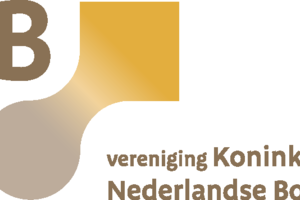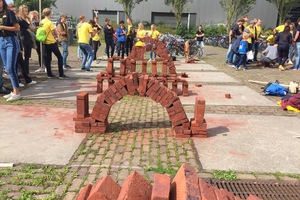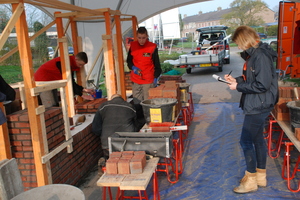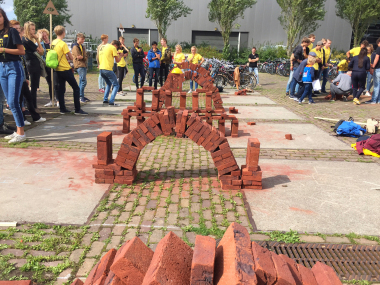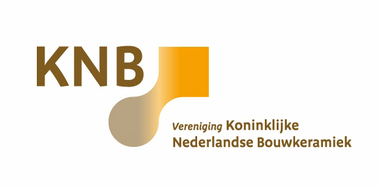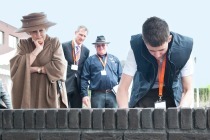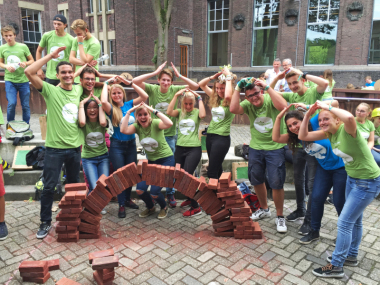Exports push Dutch clay brick and tile industry
The strong growth of the Dutch construction industry was not reflected in the domestic sales of Dutch facing bricks in 2017 (-2%). Export sales were clearly positive at +17%. The total sales of clay pavers were also much better both at home and abroad (+10%). The market for clay roofing tiles declined slightly.
1 Building industry in the Netherlands
According to EIB (a sectoral Economic Research Institute for Construction and Housing), the Dutch construction industry showed very substantial growth for the third year in a row in 2017.
The housing construction sector was the driving force behind this (+10%). Although this growth was initially delayed by weak development in the granting of permits in 2016, there was an unexpected leap ahead in the last quarter of 2017. According to Buildsight, 58250 new houses were completed in 2017 (+8%). According to preliminary statistics (April 2018), the number of permits granted for new residences has risen to 69600 (+36%).
2 Sales of building ceramics
The strong growth of the Dutch construction industry was not immediately visible in the domestic sales of the Dutch brick industry in 2017. Total sales for facing bricks grew by 5% to 876 mill. WF, but that was export-driven (+17%). Domestic sales fell by almost 2% and domestic consumption of facing bricks also declined to just under 600 mill. WF (-4%). Sales of clay pavers increased significantly (+10%). Sales of clay pavers in mechanical packages rose by 6%, the same growth that was experienced by “Keiformaat” pavers in 2017. As this type is almost always used in roads and streets, the equal growth in the sales of mechanical packages suggests that mechanical processing is on the right track.
The market for ceramic roofing tiles fell slightly in 2017. The share of ceramics used on pitched roofs remained at the same level compared to that of other materials. In 2017, the market share of larger roofing tile models increased at the expense of the traditional smaller roofing tile models.
3 Outlook
Expectations for the coming years of the Dutch construction industry remain positive.
According to Buildsight, the housebuilding sector, a relevant market for facing bricks, is expected to yield 63500 new houses in 2018. The construction of buildings for the public sector will also increase as well as the renovation market, which is a relevant sales area for ceramic roofing tiles.
After 2018, further growth in housing construction will nevertheless be adversely affected because of rising costs and (particularly) a lack of building land and skilled workers.
4 Climate and energy policy framework
The KNB “Destined for the Future” Sustainability Agenda outlines the level of ambition of the building ceramics industry in the medium term. The major focus had already been on energy conservation and emission reduction, but in 2017 the focus was also on recyclability and opportunities to use energy from renewable sources. Electrification, green gas and hydrogen gas are potentially promising, but they require exceptional in-depth research before they can be applied in the heavy clay industry.
For the short term, the focus is especially on the phasing out of natural gas supply from the province of Groningen. This is an area in the north of the Netherlands that has recently been prone to many earthquakes. These are the consequences of the extensive natural gas extraction up until now. For political reasons it was therefore decided to terminate natural gas extraction in the north. Dutch industry is to shift to another kind of (gas) energyresources, which, however, is a huge challenge.
In spring, KNB presented the first release of the study “The added value of clay extraction” to the Chairman of the parliamentary committee, Ms Stientje van Veldhoven, who has in the meantime become State Secretary for Infrastructure and Water. The study shows the results of the alliance between clay extraction for fired construction products, river widening and environmental development. The public can read about the results of sustainable clay extraction for building ceramics at www.kleiwinning.nl, the new website launched in 2017.
Self-supporting outer cavity panels in brick masonry are very suitable for nearly zero-energy apartment buildings (BENG), as shown in a study commissioned by KNB. At the Building Holland 2017 trade fair, the research findings were presented by KNB Chairman Tommel to the programme manager of the Spring Agreement, a collaboration between the government, project developers and construction businesses. It was the start of a long period of information session in the construction chain for which KNB organized various themed meetings.
5 Education and information transfer
The 2017 Dutch National Bricklaying Championship (“anno 1953”) was the 65th bricklaying championship that had been initiated by KNB. The finals workpiece was based on a design by students from the University of Delft. KNB, in collaboration with Stylos student union, has been organizing an introduction for first-year building engineering students for some time now. This has yielded very enthusiastic and committed students.
Triggered by the reforms in construction education in pre-vocational secondary education, KNB has developed a very popular bricklaying course for building construction teachers working in pre-vocational secondary education.
KNB regularly publishes info magazines and brochures for design and executive professional practice. In 2017, the KNB “Supporting structures above wall openings” brochure was updated.
Furthermore, an info magazine on the insulation of cavity walls was published as well as magazines on the insulation of cavity walls in new houses and the product specifications of facing bricks in accordance with European Standard 771-1 and the accompanying declaration of performance.
Together with manufacturers of mortar, sand-lime, cellular concrete and concrete blocks KNB participates, on behalf of the brick industry, in the Stacked Construction Association. In its capacity as a knowledge centre for masonry, Stacked Constructionhas published two new Technical Recommendations (TA).
KNB – Vereniging Koninklijke Nederlandse Bouwkeramiek
www.knb-keramiek.nl

